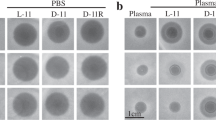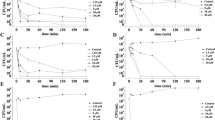Abstract.
The compositional difference in microbial and human cell membranes allows antimicrobial peptides to preferentially bind microbes. Peptides which specifically target lipopolysaccharide (LPS) and palmitoyl-oleoyl-phosphatidylglycerol (POPG) are efficient antibiotics. From the core LPS-binding region of Factor C, two 34-mer Sushi peptides, S1 and S3, were derived. S1 functions as a monomer, while S3 is active as a dimer. Both S1 and S3 display detergent-like properties in disrupting LPS aggregates, with specificity for POPG resulting from electrostatic and hydrophobic forces between the peptides and the bacterial lipids. During interaction with POPG, the S1 transitioned from a random coil to an α-helix, while S3 resumed a mixture of α-helix and β-sheet structures. The unsaturated nature of POPG confers fluidity and enhances insertion of the peptides into the lipid bilayer, causing maximal disruption of the bacterial membrane. These parameters should be considered in designing and developing new generations of peptide antibiotics with LPS-neutralizing capability.
Similar content being viewed by others
Author information
Authors and Affiliations
Corresponding author
Additional information
Received 2 October 2007; received after revision 2 November 2007; accepted 4 December 2007
J. L. Ding, B. Ho: Co-senior authors.
Rights and permissions
About this article
Cite this article
Ding, J.L., Li, P. & Ho, B. The Sushi peptides: structural characterization and mode of action against Gram-negative bacteria. Cell. Mol. Life Sci. 65, 1202–1219 (2008). https://doi.org/10.1007/s00018-008-7456-0
Published:
Issue Date:
DOI: https://doi.org/10.1007/s00018-008-7456-0




